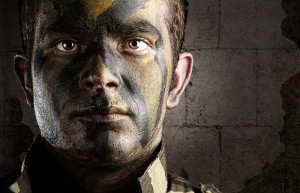How Mindfulness Meditation Can Help Treat Traumatic Brain Injuries (for Veterans)
Categories: Health and Wellness, Meditation and Military, News
 It goes without saying that, veterans are a different breed of people. They’ve withstood some of the worst hardships an individual can possibly face. They’ve seen more of the world than most of us ever will; and they’ve experienced some of life’s greatest treasures – but also, some of the worst. Death, destruction and injury are just some of the inevitable, negative effects of war that are, unfortunately, all too common. Fortunately, however, symptoms of one of the worst injuries a veteran can endure — a traumatic brain injury, as horrific and debilitating as they are — can actually be treated, or made better, through the practice of mindfulness meditation. These same practices can also help those of us who haven’t been directly affected by war, to better welcome veterans who have experienced that, back in to the world with open arms.
It goes without saying that, veterans are a different breed of people. They’ve withstood some of the worst hardships an individual can possibly face. They’ve seen more of the world than most of us ever will; and they’ve experienced some of life’s greatest treasures – but also, some of the worst. Death, destruction and injury are just some of the inevitable, negative effects of war that are, unfortunately, all too common. Fortunately, however, symptoms of one of the worst injuries a veteran can endure — a traumatic brain injury, as horrific and debilitating as they are — can actually be treated, or made better, through the practice of mindfulness meditation. These same practices can also help those of us who haven’t been directly affected by war, to better welcome veterans who have experienced that, back in to the world with open arms.
Mindfulness meditation is the subtle effort, in continuity, to be present in mind, body and spirit, regardless of past experiences, current situations and emotions, and even our own environment. What may stress out the typical person, can be relieved through mindfulness meditation. The same can be said for veterans who’ve experienced some sort of traumatic brain injury.
One of the best things a person who’s experienced any sort of brain injury can do is understand that the injuries incurred aren’t necessarily permanent. Non-traditional treatments, such as mindfulness meditation, can have a profound impact on the betterment of the individual’s brain after an injury. Unfortunately, many traditional medical doctors tend to diagnose a traumatic brain injury as a damaged or pulled muscle, which isn’t necessarily correct — at least in fullness. This is especially the case because, in addition to the physical injury caused by the impact, there’s also neurological and psychological damage that needs to be recognized and treated just as equally. While a medical doctor can better help with the physical injuries inflicted, mindfulness meditation can help greatly reduce the neurological and psychological effects of the injury.
Mindfulness meditation has also been seen to help individuals with cognitive and behavioral issues such as Attention Deficit Hyperactive Disorder (ADHD), Obsessive Compulsive Disorder (OCD), and Post-Traumatic Stress Disorder (PTSD) — the latter being yet another unfortunate consequence many veterans experience after war.
The great news is, mindfulness meditation can be practiced by any individual who’s willing to go the distance. After just a few weeks of practicing mindfulness and meditation, you will begin to experience a heightened awareness of your mental state, which can, in turn, help reduce some of the effects of certain traumatic brain injuries. This also means that a veteran will soon become more “in tune” with his or her own recovery.
Although mindfulness meditation isn’t a patentable means of treatment — medicinally speaking — such alternative and holistic treatments are being used more and more in both physical and mental injuries. And this isn’t by chance. The effects of treatment can be made greater when mindfulness meditation is part of your regime. When practiced congruently, mindfulness meditation can help pave your road to full recovery.
To help restore your brain back to its optimum performance at this given time and space, begin by becoming aware.
To do this, sit up, with your back straight in a chair, and your feet resting gently on the floor beneath you. Close your eyes, and ponder the following:
What am I currently experiencing?
What’s currently running through my mind?
What am I currently feeling?
What physical sensation am I currently feeling (i.e. tightness, stiffness, acute pain, etc.)?
While pondering the above emotions and feelings, you should then begin to transfer your focus to your breathing. Become one with the act of breathing by feeling your belly as it moves in and out: Follow your breath in and out and use it as a way to become present in your current experience. Finish by feeling your body as a whole to expand your awareness: From the inside to the outside — your complete being. Everything from your facial expression to your stance should be felt entirely.
Note: Specifically, with regards to medical issues, always seek the advice of your physician or other qualified health provider with any questions you may have regarding a medical condition. Never disregard professional medical advice or delay in seeking it because of something you have read on the Web site.
